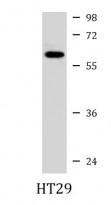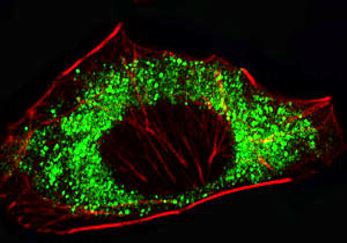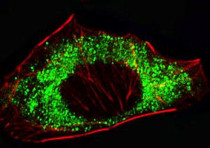anti-Src antibody
CAT.NO. : ARG54712
US$ Please choose
US$ Please choose
概述
| 产品描述 | Mouse Monoclonal antibody recognizes Src |
|---|---|
| 反应物种 | Hu, Ms |
| 应用 | ICC/IF, WB |
| 宿主 | Mouse |
| 克隆 | Monoclonal |
| 克隆号 | 17AT28 |
| 同位型 | IgG1 |
| 靶点名称 | Src |
| 抗原物种 | Human |
| 抗原 | Human Src recombinant protein (NP_005408.1). |
| 偶联标记 | Un-conjugated |
| 別名 | Proto-oncogene c-Src; ASV; p60-Src; c-SRC; Proto-oncogene tyrosine-protein kinase Src; SRC1; pp60c-src; EC 2.7.10.2 |
应用说明
| 应用建议 |
| ||||||
|---|---|---|---|---|---|---|---|
| 应用说明 | * The dilutions indicate recommended starting dilutions and the optimal dilutions or concentrations should be determined by the scientist. | ||||||
| 阳性对照 | HT29 |
属性
| 纯化 | Protein G purified |
|---|---|
| 缓冲液 | PBS and 0.09% (W/V) Sodium azide |
| 抗菌剂 | 0.09% (W/V) Sodium azide |
| 存放说明 | For continuous use, store undiluted antibody at 2-8°C for up to a week. For long-term storage, aliquot and store at -20°C or below. Storage in frost free freezers is not recommended. Avoid repeated freeze/thaw cycles. Suggest spin the vial prior to opening. The antibody solution should be gently mixed before use. |
| 注意事项 | For laboratory research only, not for drug, diagnostic or other use. |
生物信息
| 数据库连接 | Swiss-port # P05480 Mouse Neuronal proto-oncogene tyrosine-protein kinase Src Swiss-port # P12931 Human Proto-oncogene tyrosine-protein kinase Src |
|---|---|
| 基因名称 | SRC |
| 全名 | SRC proto-oncogene, non-receptor tyrosine kinase |
| 背景介绍 | This gene is highly similar to the v-src gene of Rous sarcoma virus. This proto-oncogene may play a role in the regulation of embryonic development and cell growth. The protein encoded by this gene is a tyrosine-protein kinase whose activity can be inhibited by phosphorylation by c-SRC kinase. Mutations in this gene could be involved in the malignant progression of colon cancer. Two transcript variants encoding the same protein have been found for this gene. [provided by RefSeq, Jul 2008] |
| 生物功能 | Non-receptor protein tyrosine kinase which is activated following engagement of many different classes of cellular receptors including immune response receptors, integrins and other adhesion receptors, receptor protein tyrosine kinases, G protein-coupled receptors as well as cytokine receptors. Participates in signaling pathways that control a diverse spectrum of biological activities including gene transcription, immune response, cell adhesion, cell cycle progression, apoptosis, migration, and transformation. Due to functional redundancy between members of the SRC kinase family, identification of the specific role of each SRC kinase is very difficult. SRC appears to be one of the primary kinases activated following engagement of receptors and plays a role in the activation of other protein tyrosine kinase (PTK) families. Receptor clustering or dimerization leads to recruitment of SRC to the receptor complexes where it phosphorylates the tyrosine residues within the receptor cytoplasmic domains. Plays an important role in the regulation of cytoskeletal organization through phosphorylation of specific substrates such as AFAP1. Phosphorylation of AFAP1 allows the SRC SH2 domain to bind AFAP1 and to localize to actin filaments. Cytoskeletal reorganization is also controlled through the phosphorylation of cortactin (CTTN). [UniProt] |
| 细胞定位 | Cell membrane. Mitochondrion inner membrane. Nucleus. Cytoplasm, cytoskeleton. Note=Localizes to focal adhesion sites following integrin engagement. Localization to focal adhesion sites requires myristoylation and the SH3 domain |
| 产品亮点 | Related Antibody Duos and Panels: ARG30169 Src Family Protein Tyrosine Kinases Antibody Panel ARG30170 Phospho Src Antibody Panel Related products: Src antibodies; Src ELISA Kits; Src Duos / Panels; |
| 研究领域 | Cancer antibody; Gene Regulation antibody; Signaling Transduction antibody; Src Family Protein Tyrosine Kinases antibody |
| 预测分子量 | 60 kDa |
| 翻译后修饰 | Myristoylated at Gly-2, and this is essential for targeting to membranes. Dephosphorylated at Tyr-530 by PTPRJ (By similarity). Phosphorylated on Tyr-530 by c-Src kinase (CSK). The phosphorylated form is termed pp60c-src. Dephosphorylated by PTPRJ at Tyr-419. Normally maintained in an inactive conformation with the SH2 domain engaged with Tyr-530, the SH3 domain engaged with the SH2-kinase linker, and Tyr-419 dephosphorylated. Dephosphorylation of Tyr-530 as a result of protein tyrosine phosphatase (PTP) action disrupts the intramolecular interaction between the SH2 domain and Tyr-530, Tyr-419 can then become autophosphorylated, resulting in SRC activation. Phosphorylation of Tyr-530 by CSK allows this interaction to reform, resulting in SRC inactivation. CDK5-mediated phosphorylation at Ser-75 targets SRC to ubiquitin-dependent degradation and thus leads to cytoskeletal reorganization. Phosphorylated by PTK2/FAK1; this enhances kinase activity. Phosphorylated by PTK2B/PYK2; this enhances kinase activity. S-nitrosylation is important for activation of its kinase activity. Ubiquitinated in response to CDK5-mediated phosphorylation. Ubiquitination mediated by CBLC requires SRC autophosphorylation at Tyr-419 and may lead to lysosomal degradation. |
检测图片 (2)
ARG54712 anti-SRC Antibody ICC/IF image
Immunofluorescence: A549 cells were fixed with 4% PFA (20 min), permeabilized with Triton X-100 (0.1%, 10 min), then stained with ARG54712 anti-SRC antibody (1:25, 1 h at 37°C). Cytoplasmic actin was counterstained with Alexa Fluor® 555 (red) conjugated Phalloidin (7 units/ml, 1 h at 37°C).
ARG54712 anti-SRC Antibody WB image
Western blot: 35 µg of HT29 cell lysate stained with ARG54712 anti-SRC antibody at 1:1000 dilution.
 New Products
New Products























